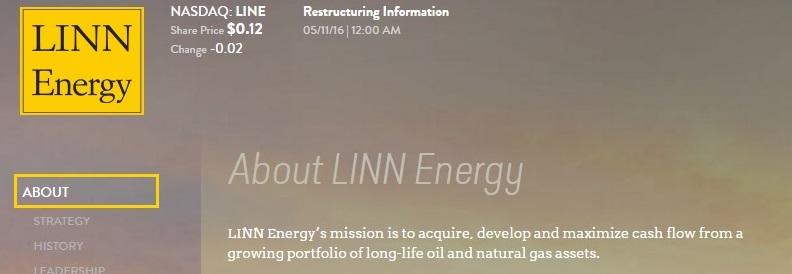Why Linn Energy Was the Wrong Kind of MLP
Last week Linn Energy (LINE) filed for bankruptcy. Over the past year or so we’ve come across quite a few people whose exposure to Master Limited Partnerships (MLPs) regrettably included LINE. They were attracted by the yield, whose steady rise until 2013 belied the unpredictability of their cashflows. LINE was engaged in Exploration and Production (E&P), and so they were always going to be a bet on the price of crude oil. The company bought acreage when crude was at $100, so it was always going to be challenging for them once it collapsed. The stability of their distribution didn’t reflect economic reality.
Back in 2013 there were also questions raised in Barrons about LINE’s accounting treatment for options that were used to hedge their output. The SEC subsequently investigated. We typically avoid E&P companies anyway, but whether the criticisms of non-GAAP treatment were justified or not, LINE wasn’t making it easy for investors to analyze their financial statements. Their website, which now includes information on their restructuring, says, “LINN Energy’s mission is to acquire, develop and maximize cash flow from a growing portfolio of long-life oil and natural gas assets.”

MLP investors were originally seeking stable income, although the 2015 rout has in our opinion created the most deeply undervalued sector in the equity markets. A cute bit of Math is that a 2% drop in yields (through price appreciation) will generate no less than a 30% total return[1] over one year for any equity sector (or individual equity security). Only MLPs offer this kind of potential.
Although E&P companies can and do structure themselves as MLPs, their returns are ill-suited to the traditional MLP investor base. During 2014-15 every single E&P MLP in the Alerian Index cut or eliminated their distribution. This drove the drop in distributions on the index and fueled fears of further distribution cuts across the rest of the sector. The rules under which the index is constructed require that a distribution cut causes the offending name to be ejected from the index, so although there are still E&P MLPs, the leading index has gradually been relieved of their burden.
Because MLPs normally pay out most of their cashflow, an E&P business is particularly ill-suited to this form of organization. If you own an asset (crude oil in the ground) and you distribute the net proceeds from its extraction to your equity investors, your underlying asset base is depleting. You may confuse the issue by investing in new crude oil acreage with new capital raised, but eventually the music will stop. The collapse in crude kicked the CD player off the chair sooner than expected for some, but it’s not a sustainable model.
This contrasts with owning an asset that’s appreciating, such as an installed pipeline whose replication becomes ever more expensive as development goes on around and above it. Many pipelines would cost multiples of their original cost to build today with population centers having grown up, easements harder to obtain and regulatory approvals ever more demanding. This is a business built on sending back the recurring cashflows earned from renting out its capacity.
Both business models, the depleting asset and the recurring cashflow from rented capacity, can legally exist as MLPs. But they’re not to be confused with one another. The market dislocation of last year is cleansing the sector of weaker models, leading to a quality upgrade. LINE was the wrong kind of MLP. Their distributions were the result of using up their reserves in the ground. In effect, they were returning capital to investors rather than profits, although the collapse in crude oil hastened their demise. While it was unpleasant for investors in LINE, they’ll better appreciate the more secure foundation of their other MLP holdings.
[1] For example: a security priced at $6 pays a $0.60 dividend, yielding 10%. Over the next year its price rises to $7.50, causing its yield to drop to 8%. The $1.50 price gain plus the $0.60 distribution equals a $2.10 return on the original $6 investment, or 35%.